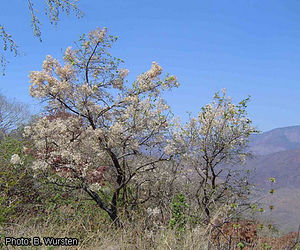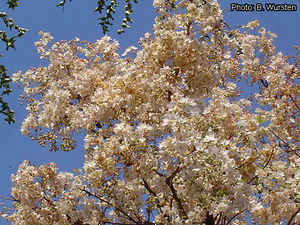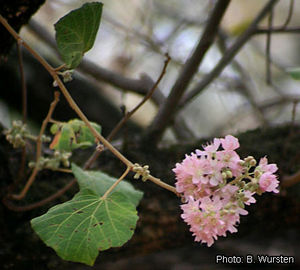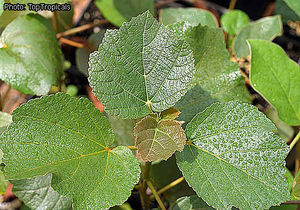Dombeya rotundifolia (PROTA)
Introduction |
| General importance | |
| Geographic coverage Africa | |
| Geographic coverage World | |
| Carbohydrate / starch | |
| Medicinal | |
| Timber | |
| Fuel | |
| Ornamental | |
| Forage / feed | |
| Auxiliary plant | |
| Climate change | |
| Conservation status | |
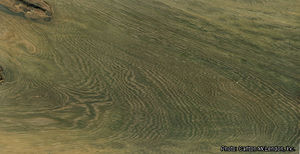
Dombeya rotundifolia (Hochst.) Planch.
- Protologue: Fl. Serres Jard. Eur. 6: 225 (1850–1851).
- Family: Sterculiaceae (APG: Malvaceae)
- Chromosome number: 2n = 56
Vernacular names
- Wild pear, common wild pear, dombeya (En).
- Mtorobwe, mkebu (Sw).
Origin and geographic distribution
Dombeya rotundifolia is distributed from Ethiopia southward through Central, East and southern Africa to Angola, Namibia, Botswana, South Africa and Swaziland.
Uses
The strong but flexible branches of Dombeya rotundifolia are made into poles, bows, tool handles and ornaments. The wood is also used as firewood. The young bark is made into rope. The leaves serve as fodder. The flowers are visited by bees that use the nectar to produce pale amber-coloured honey. The tree has ornamental value and is an excellent avenue tree. It can be trained as a bonsai.
In East Africa the boiled root is pounded and soaked in water, and the liquid is drunk by children to treat diarrhoea. Boiled roots are also applied to treat rheumatism, and root decoctions are drunk against stomach pain. An infusion of the root is drunk to treat syphilis, and the root is used in the treatment of infertility. A bark decoction is drunk against dizziness and meningitis. In southern Africa infusions of the bark, wood, stems, leaves or roots are taken orally or applied as enema to treat intestinal ulcers, haemorrhoids, diarrhoea and stomach problems. A decoction of the bark is taken against chest complaints, palpitations, cardiac weakness, fever, irregular periods, to hasten the onset of labour, and against nausea in pregnant women.
Properties
The wood of Dombeya rotundifolia is bluish grey. The grain is interlocked, texture fine. The wood is heavy, strong, tough and durable.
Ethanolic and dichloromethane extracts of the leaves and young shoots of Dombeya rotundifolia from South Africa have shown anti-inflammatory activity; antibacterial activity was highest in the ethanolic extracts. Tannins are present in the leaf and young shoot, saponins in the bark, and cardiac glycosides in the leaf, shoot and bark.
Description
- Small tree up to 9(–15) m tall; bark dark grey, dark brown or blackish, thick, rough and deeply longitudinally furrowed; crown light and usually rounded; young branches reddish and hairy, older ones dark brown to purplish.
- Leaves alternate, simple; stipules 3–6 mm × 1–2 mm, caducous; petiole up to 9(–17) cm long; blade broadly obovate to broadly reniform, very rarely slightly lobed, 3–21(–33) cm × 3–24(–33) cm, shortly hairy, leathery, base cordate, apex acute to rounded, margin usually toothed, basal veins 5–7(–9).
- Inflorescence an axillary, compound, raceme-like or umbel-like cyme, borne in fascicles of 2–5, hairy, many-flowered; peduncle up to 6(–10) cm long; branches 0.5–2.5 cm long.
- Flowers bisexual, regular, 5-merous, fragrant; pedicel 4–20 mm long; calyx with short tube, lobes 5–7 mm × 1.5–4 mm, hairy outside; petals obliquely obovate, 7–14 mm × 4–9 mm, white to pale pink, persistent and papery in fruit; stamens up to 7 mm long, in 5 groups of 2–3(–4) alternating with 5 linear staminodes 4–9 mm long, all united into a basal tube 0.5–1 mm long; ovary superior, depressed globose, hairy, 3-celled, style c. 2 mm long, stigmas usually 3.
- Fruit a depressed-globose capsule 5–6 mm in diameter, pale brown or cream, long-hairy, 1–3-seeded.
- Seeds trigonous, c. 3 mm × 2.5 mm, brown, testa slightly wrinkled.
- Seedling with epigeal germination.
Other botanical information
Dombeya comprises about 200 species, mainly distributed in Madagascar, with about 20 species in mainland Africa.
Dombeya cymosa
Dombeya cymosa Harv. (Natal wild pear or Natal dombeya) is a shrub or small tree up to 8 m tall. It is distributed from southern Mozambique southward into South Africa and Swaziland, and it occurs from sea-level up to 1200 m altitude on river banks, in forest margins, and in semi-evergreen bushland and scrub forest, often in rocky locations. The wood is dark brown, fine-grained, hard and suitable for ornaments. Excellent honey is recorded to be produced by bees visiting the plant.
Dombeya kirkii
Closely related to Dombeya cymosa is Dombeya kirkii Mast. (river wild pear or river dombeya; synonym: Dombeya mukole Sprague), a shrub or tree up to 15 m tall, distributed from Ethiopia through DR Congo and East Africa to South Africa. It occurs up to 2200 m altitude along rivers, in forest edges, woodland and bushland, often in rocky locations, and occasionally in dry forest margins. The branches of Dombeya kirkii are used in construction and for making bows and arrows, spear shafts and tool handles. They are also used as fuel. The bark is made into cordage and a decoction of the root is drunk against yaws and abdominal pain in East Africa. The tree is used for ornamental purposes.
Germination of Dombeya rotundifolia is usually completed within 3 weeks and growth is fast. Flowering often occurs before the start of the rainy season, when the tree is leafless. In southern Africa flowering is in July–October, and fruiting in October–December.
Ecology
Dombeya rotundifolia occurs up to 2250 m altitude in grassland, woodland and forest, often on termite mounds. In East Africa it is usually found above 1000 m altitude, but in southern Africa almost as low as sea-level. Dombeya rotundifolia is sun-loving, hardy and resistant to drought, frost and fire.
Management
Dombeya rotundifolia can easily be propagated from seed. There are 35,000–40,000 seeds/kg. At room temperature viability of the seed is retained for about 3 months only. Seedlings and young plants transplant well. Seedlings may also be collected from the wild. Lopping and pollarding of the tree are possible.
Genetic resources
In view of its wide distribution, Dombeya rotundifolia is not threatened with genetic erosion. The variation within Dombeya rotundifolia is much wider in Angola and Namibia than in the eastern part of the distribution area.
Prospects
At present the wood of Dombeya rotundifolia is only used locally and for only a few specific purposes. It is considered to have limited potential as a general purpose timber, because the pieces available are usually too small and twisted.
Major references
- Beentje, H.J., 1994. Kenya trees, shrubs and lianas. National Museums of Kenya, Nairobi, Kenya. 722 pp.
- Coates Palgrave, K., 1983. Trees of southern Africa. 2nd Edition. Struik Publishers, Cape Town, South Africa. 959 pp.
- Maundu, P. & Tengnäs, B. (Editors), 2005. Useful trees and shrubs for Kenya. World Agroforestry Centre - East and Central Africa Regional Programme (ICRAF-ECA), Technical Handbook 35, Nairobi, Kenya. 484 pp.
- Seyani, J.H., 1991. The genus Dombeya (Sterculiaceae) in continental Africa. Opera Botanica Belgica 2. National Botanic Garden of Belgium, Meise, Belgium. 186 pp.
- Vollesen, K., 1995. Sterculiaceae. In: Edwards, S., Mesfin Tadesse & Hedberg, I. (Editors). Flora of Ethiopia and Eritrea. Volume 2, part 2. Canellaceae to Euphorbiaceae. The National Herbarium, Addis Ababa University, Addis Ababa, Ethiopia and Department of Systematic Botany, Uppsala University, Uppsala, Sweden. pp. 165–185.
Other references
- Germain, R. & Bamps, P., 1963. Sterculiaceae. In: Robyns, W., Staner, P., Demaret, F., Germain, R., Gilbert, G., Hauman, L., Homès, M., Jurion, F., Lebrun, J., Vanden Abeele, M. & Boutique, R. (Editors). Flore du Congo belge et du Ruanda-Urundi. Spermatophytes. Volume 10. Institut National pour l’Étude Agronomique du Congo belge, Brussels, Belgium. pp. 205–316.
- Kokwaro, J.O., 1993. Medicinal plants of East Africa. 2nd Edition. Kenya Literature Bureau, Nairobi, Kenya. 401 pp.
- Lovett, J.C., Ruffo, C.K., Gereau, R.E. & Taplin, J.R.D., 2006. Field guide to the moist forest trees of Tanzania. [Internet] Centre for Ecology Law and Policy, Environment Department, University of York, York, United Kingdom. http://www.york.ac.uk/res/celp/webpages/projects/ecology/tree%20guide/guide.htm. April 2006.
- Neuwinger, H.D., 2000. African traditional medicine: a dictionary of plant use and applications. Medpharm Scientific, Stuttgart, Germany. 589 pp.
- Reid, K.A, Jäger, A.K. & van Staden, J., 2001. Pharmacological and phytochemical properties of Dombeya rotundifolia. South African Journal of Botany 67(2): 349–353.
- Steenkamp, V., 2003. Traditional herbal remedies used by South African women for gynaecological complaints. Journal of Ethnopharmacology 86: 97–108.
- Storrs, A.E.G., 1979. Know your trees: some of the common trees found in Zambia. Forest Department, Ndola, Zambia. 380 pp.
- van Wyk, B.E., van Oudtshoorn, B. & Gericke, N., 1997. Medicinal plants of South Africa. Briza Publications, Pretoria, South Africa. 304 pp.
- van Wyk, B. & van Wyk, P., 1997. Field guide to trees of southern Africa. Struik Publishers, Cape Town, South Africa. 536 pp.
- Verdoorn, I.C. & Herman, P.P.J., 1986. Revision of the genus Dombeya (Sterculiaceae) in southern Africa. Bothalia 16(1): 1–9.
Author(s)
- M. Brink, PROTA Network Office Europe, Wageningen University, P.O. Box 341, 6700 AH Wageningen, Netherlands
Correct citation of this article
Brink, M., 2007. Dombeya rotundifolia (Hochst.) Planch. In: Louppe, D., Oteng-Amoako, A.A. & Brink, M. (Editors). PROTA (Plant Resources of Tropical Africa / Ressources végétales de l’Afrique tropicale), Wageningen, Netherlands. Accessed 22 December 2024.
- See the Prota4U database.

